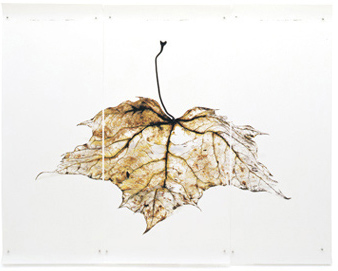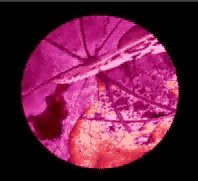 |
|
Black Pulse 15 Lambda
Absorption + Transmission
Commissioned by The National Accademy of Sciences
Inaugurated Washington DC, March 18 – July 15, 2005
| 2006 March 11 – April 4 FotoFest 2006 Houston, TX |
2006 April 21 – June 17 Wood Street Galleries Pittsburgh, PA |
2006 May 13 – October 8 Stedelijk Museum De Lakenhal Leiden, The Netherlands |
| artists' notes Absorption + Transmission refers to leaves, trees and photographs absorbing light (and the absorbing of light being its opposite). In almost any culture in the history of the world, light is used as a metaphor for thought, knowledge, intelligence... With this metaphor as our foundation, we recognize that a tree grows toward light, and of course, it uses light in the process of photosynthesis, partly to remove carbon from the air, and important to our metaphor, carbon is the primary matter of the body of the tree. The carbon atom, in most states, is black. Besides black being the absence of light it, is also the complete absorption of light. In fact, in physics terminology, carbon is a "black body radiator"—perfectly absorbing and capable of perfectly emitting all wavelengths of light. Carbon for us is the representation of the absorption of light (figuratively thought and information). The black silhouette of the tree represents the absorbed light. The structure of thought is a living dendritic accumulation of intersections and layers. We had been working on the series Structure of Thought for a couple of years, and the silhouetted trees already symbolized the layers and layers of sensory input, memories, emotion, imagination and ideas. For us, the dendritic and rhizomatic form presented broad dynamic fluid movement between points all connected or able to connect, so when we stumbled upon the same form in the image of a brain neuron we felt validated. The dendritic form gives the pathway for the complicated and the continually capable of changing connections in the transmission of impulses. And in a delightful coincidence, the way the living neurons are imaged is bioluminenesence (harvested from a jellyfish or firefly) is expressed into a single neuron and the neuron becomes illuminated (and a photomicrograph is taken of it)—the neuron absorbs the light. –D+M Starn  Black Pulse Video animation (downloadable video 15.2MB) Press Release Absorption + Transmission features large scale prints from two of Mike and Doug Starn’s recent bodies of work, Structure of Thought and Black Pulse. Over the past ten years, the Starns have embarked on a metaphorical exploration of light as a requisite for photography and vision, and as a symbol of enlightenment. Their investigations have led them to create the two bodies of work on display in which they feature light as a life force, and draw parallels between the structure of flora and the human body. Structure of Thought includes images of branching trees that resemble the microscopic dendrites of neurons in the brain. Images from Black Pulse, the Starns' other series on view, were created by scanning and digitally stripping leaves, layer by layer, to reveal their veins.  Structure of Thought 13 Structure of Thought 13The Starns’ work has been exhibited in museums worldwide for two decades with their most ambitious projects realized most recently; in the spring of 2004, the Neuberger Museum of Art (Purchase, NY) featured Behind Your Eye which coincided with the release of a new monograph entitled Attracted to Light, during the winter of 2004-05 the Färgfabriken Kunsthalle (Stockholm, Sweden) premiered Gravity of Light, an exhibition of photographs illuminated by a single blindingly bright arc lamp. They have received critical acclaim in The New York Times, Art in America, Artforum, Flashart, and other international publications. Mike and Doug Starn are recipients of two National Endowment for the Arts grants (1987 and 1995). Their work is included in the collections of several major museums, including the Corcoran Gallery of Art (Washington, DC), the Metropolitan Museum of Art (NYC), and the Museum of Modern Art (NYC). Reviews: Washington Post by Paul Richard Washington Diplomat by Daniel Brill Houston Chronicle by Patricia Johnson Pittsburgh Post-Gazette by Mary Thomas |